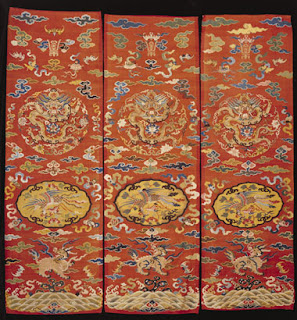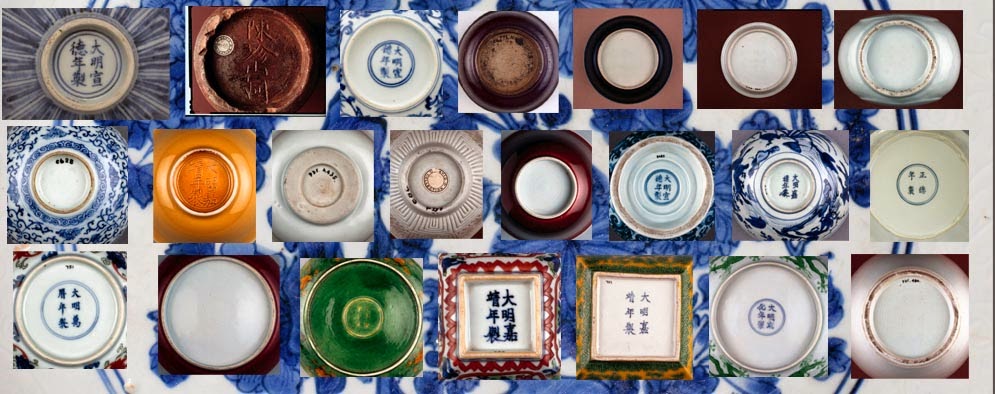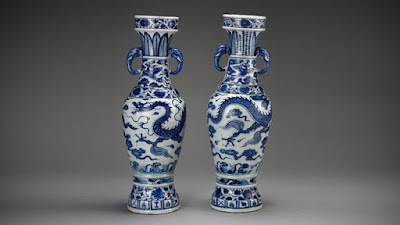Chinese Dragon Robes and Textiles, The China Trade In Massachusetts
A Brief History on Chinese Dragon Robes and Textiles, the China Trade in Massachusetts and how it got started
 |
| Kangxi Period (1662-1722), Chinese Kesi Chair Covers |
The above comment was not a knock on Canton Wares, but they are pretty common and were shipped here by the boatload, literally in wooden barrels. As an aside, I can still recall my own grandmother's basement had several of these barrels, some were open and stuffed with straw and packed with dishes to tureens, others were still sealed. When a piece broke during use, she would toss it out and simply go down and get another from a barrel. Despite this being in the 1960's, many of them were not marked "CHINA" meaning they came over before 1896...and by the 1960's were still as yet not all open and being used.
Now onto the Chinese Robes and textiles. Why so many ended up here in New England and particularly along Boston's North Shore is for several reasons. Its a true confluence of of politics, wealth, trade and disaster.

Chinese Ming Dynasty Imperial Robe China Trading Ships from Salem, MA. During the late 18th and into the19th C., hundreds of ships departed Salem each year for Asia. They would work their way around the world buying and selling at many ports along the coast of Europe, Africa, India and then onto China. In a sense these trading ships worked as floating stores, buying in one port and selling in another as they progressed. Later these ships would return to Salem loaded with goods from Asia, including silk, spices, tea, porcelain and cotton. Among all the things brought back tea was by far the largest commodity in value, by 1860 it accounted for over 60% of the cargoes. Along with it all came bolts of silk and silk needlework. The China Trade Period was truly an amazing time.- Chinese Silk is best in the world, in the 18th and 19th C. as a fabric it was held in particularly high esteem by everyone, including foreigners and was highly sought by people of means for furnishing houses as drapes and upholstery as well as some clothing. Well to do American ladies were not immune to it's charm. It was a very exotic material after all, produced by spiders! So in came silk to the North Shore of Boston by the trunk full, quite literally, for many years.
-

Chinese Fur Lined Winter Court Robe,
Qianlong Period, 18th C.Opportunity! China's Economic woes were the West's gain. Eventually by the late 19th C. and into the early 20th C. China's economy was heading into an abyss. Excessive spending by the Imperial household, Opium Wars, the Taiping Rebellion, social upheavals, over population etc. In general it was a total mess. In the 1860's the French and British sacked the Summer palace known as the Yuan Min Yuan or the Old Summer Palace during the Second Opium war. The Chinese under the Xianfeng Emperor had tortured and executed 20 British soldiers during a peace negotiation, the sacking of the Palace was in retaliation. Xianfeng died the following year at the age of 30. Consequently virtually everything from the 1860's onward was falling apart and was becoming for sale at bargain prices. Things worsened as China scrambled for foreign currency, selling off anything that wasn't nailed down including fine porcelain, statues, jades and Imperial court robes. Resulting in more silk being brought to America, much of it in the form of robes and clothing in addition to bolts and bolts of fine silk. -

Qianlong Period Court Robe, 18th C.
Dragons on Yellow SilkTiming and taste is everything! As luck would have it, the taste for all things Asian, including Chinese of course, was now a generational favorite among the families ensconced on Beacon Hill in Boston and many more who had moved or had Summer houses along Boston's Gold Coast , a term coined by author Joesph Garland . (Its a great book and fun to read!) Chinese silks and robes remained a favorite and were collected and stored in houses all over our area, often in old China Trade camphor wood trunks. They poured out of China and into waiting arms of the American and European market. Around here they became as popular as Lobster on the 4th of July!
Today many of the towns here along the shore and slightly inland to horse country, running from Gloucester to Manchester-by-the-sea, Beverly Farms, Prides Crossing, Beverly, Salem, Marblehead, Hamilton, Weham and Ipswich still have more than few houses with those trunks. Within them are Chinese silk robes, hanging Kesi panels ( Chinese tapestry weaving ), needle works and the occasional 19th C. Chinese rug.
 |
| Blue Silk Ground with Gilt Metallic Thread, 19th C. Chinese Court Robe. |
Over the years while settling estates in the area we often came across a long forgotten trunk that would get pulled from an attic for inventorying, it always seemed to be locked and no key, but with a little coaxing it could be opened without damage! Inside, carefully wrapped in fine tissue it was not unusual to find the wonderfully pretty silks from 19th C. China! China got the gold when they needed it and we got the art work.
So check your attics and back hallways, you never know what might be tucked away and long forgotten.
Feel free to email or call with any questions about your own Chinese Silks, Porcelains or Jades or their values.
Thank you for visiting ~ Peter Combs
Gloucester, MA 978-283-3524


Comments
Post a Comment
If you have any questions or comments please send us a message. Or use the Contact Us tab at the top of the page.